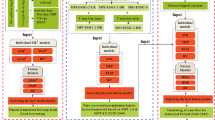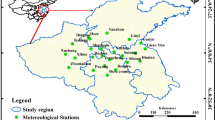Abstract
Quantitative Precipitation Forecast (QPF) is a challenging issue in seamless prediction. QPF faces the following difficulties: (i) single rather than multiple model products are still used; (ii) most QPF methods require long-term training samples not easily available, and (iii) local features are insufficiently reflected. In this work, a multi-model blending (MMB) algorithm with supplemental grid points (SGPs) is experimented to overcome these shortcomings.
The MMB algorithm includes three steps: (1) single-model bias-correction, (2) dynamic weight MMB, and (3) light-precipitation elimination. In step 1, quantile mapping (QM) is used and SGPs are configured to expand the sample size. The SGPs are chosen based on similarity of topography, spatial distance, and climatic characteristics of local precipitation. In step 2, the dynamic weight MMB uses the idea of ensemble forecasting: a precipitation process can be forecast if more than 40% of the models predict such a case; moreover, threat score (TS) is used to update the weights of ensemble members. Finally, in step 3, the number of false alarms of light precipitation is reduced, thus alleviating unreasonable expansion of the precipitation area caused by the blending of multiple models.
Verification results show that using the MMB algorithm has effectively improved the TS and bias score (BS) for blended 6-h QPF. The rate of increase in TS for heavy rainfall (25-mm threshold) reaches 20%–40%; in particular, the improvement has reached 47.6% for forecast lead time of 24 h, compared with the ECMWF model. Meanwhile, the BS is closer to 1, which is better than any single-model forecast. In sum, the QPF using MMB with SGPs shows great potential to further improve the present operational QPF in China.
Similar content being viewed by others
References
Ahmed, K., D. A. Sachindra, S. Shahid, et al., 2020: Multi-model ensemble predictions of precipitation and temperature using machine learning algorithms. Atmos. Res., 236, 104806, doi: https://doi.org/10.1016/j.atmosres.2019.104806.
Bougeault, P., Z. Toth, C. Bishop, et al., 2010: The THORPEX interactive grand global ensemble. Bull. Amer. Meteor. Soc., 91, 1059–1072, doi: https://doi.org/10.1175/2010BAMS2853.1.
Bouttier, F., and H. Marchal, 2020: Probabilistic thunderstorm forecasting by blending multiple ensembles. Tellus A, 72, 1–19, doi: https://doi.org/10.1080/16000870.2019.1696142.
Cao, Y., C. H. Liu, Z. P. Zong, et al., 2016: State-level gridded quantitative precipitation forecasting system. Meteor. Mon., 42, 1476–1482.
Chen, L. Q., X. S. Zhou, and S. Yang, 2005: A quantitative precipitation forecasts method for short-range ensemble forecasting. J. Nanjing Inst. Meteor., 28, 543–548, doi: https://doi.org/10.3969/j.issn.1674-7097.2005.04.015. (in Chinese)
Copernicus Climate Change Service (C3S), 2017: ERA5: Fifth Generation of ECMWF Atmospheric Reanalyses of the Global Climate. Copernicus Climate Change Service Climate Data Store (CDS). Available online at https://reanalyses.org/atmosphere/era5-references.
Craven, J. P., D. E. Rudack, and P. E. Shafer, 2020: National blend of models: A statistically post-processed multi-model ensemble. J. Oper. Meteor., 8, 1–14, doi: https://doi.org/10.15191/nwajom.2020.0801.
Dai, K., Y. Cao, Q. F. Qian, et al., 2016: Situation and tendency of operational technologies in short- and medium-range weather forecast. Meteor. Mon., 42, 1445–1455. (in Chinese)
Dai, K., Y. J. Zhu, and B. G. Bi, 2018: The review of statistical post-process technologies for quantitative precipitation forecast of ensemble prediction system. Acta Meteor. Sinica, 76, 493–510, doi: https://doi.org/10.11676/qxxb2018.015. (in Chinese)
Dee, D. P., S. M. Uppala, A. J. Simmons, et al., 2011: The ERA-Interim reanalysis: Configuration and performance of the data assimilation system. Quart. J. Roy. Meteor. Soc., 137, 553–597, doi: https://doi.org/10.1002/qj.828.
Ebert, E. E., 2001: Ability of a poor man’s ensemble to predict the probability and distribution of precipitation. Mon. Wea. Rev., 129, 2461–2480.
Gao, S., K. Dai, and F. Xue, 2014: The design and development of grid edit platform based on MICAPS 3.2 system. Meteor. Mon., 40, 1152–1158. (in Chinese)
Glahn, H. R., and D. P. Ruth, 2003: The new digital forecast database of the national weather service. Bull. Amer. Meteor. Soc., 84, 195–202, doi: https://doi.org/10.1175/BAMS-84-2-195.
Gorry, P. A., 1990: General least-squares smoothing and differentiation by the convolution (Savitzky-Golay) method. Anal. Chem., 62, 570–573, doi: https://doi.org/10.1021/ac00205a007.
Haiden, T., A. Kann, C. Wittmann, et al., 2011: The Integrated Nowcasting through Comprehensive Analysis (INCA) system and its validation over the eastern alpine region. Wea. Forecasting, 26, 166–183, doi: https://doi.org/10.1175/2010WAF2222451.1.
Hamill, T. M., and M. Scheuerer, 2018: Probabilistic precipitation forecast postprocessing using quantile mapping and rank-weighted best-member dressing. Mon. Wea. Rev., 146, 4079–4098, doi: https://doi.org/10.1175/MWR-D-18-0147.1.
Hamill, T. M., E. Engle, D. Myrick, et al., 2017: The U.S. national blend of models for statistical postprocessing of probability of precipitation and deterministic precipitation amount. Mon. Wea. Rev., 445, 3441–3463, doi: https://doi.org/10.1155/MWRDD-16-0331.1.
He, Y. N., S. Gao, F. Xue, et al., 2018: Design and implementation of intelligent grid forecasting platform based on MICAPS4. J. Appl. Meteor. Sci., 29, 13–24, doi: https://doi.org/10.11898/1001-7313.20180102. (in Chinese)
Huang, L. P., D. H. Chen, L. T. Deng, et al., 2017: Main technical improvements of GRAPES_Meso V4.0 and verification. J. Appl. Meteor. Sci., 28, 25–37, doi: https://doi.org/10.11898/1001-7313.20170103. (in Chinese)
Ji, L. Y., X. F. Zhi, C. Simmer, et al., 2020: Multimodel ensemble forecasts of precipitation based on an object-based diagnostic evaluation. Mon. Wea. Rev., 148, 2591–2606, doi: https://doi.org/10.1175/MWR-D-19-0266.1.
Jin, R. H., K. Dai, R. X. Zhao, et al., 2019: Progress and challenge of seamless fine gridded weather forecasting technology in China. Meteor. Mon., 44, 445–457. (in Chinese)
Kober, K., G. C. Craig, C. Keil, et al., 2012: Blending a probabilistic nowcasting method with a high-resolution numerical weather prediction ensemble for convective precipitation forecasts. Quart. J. Roy. Meteor. Soc., 138, 755–768, doi: https://doi.org/10.1002/qj.939.
Li, K., and S. Q. Yang, 2010: Image smooth denoising based on Savitzky-Golay algorithm. J. Data Acquisit. Proc., 45, 72–74, doi: https://doi.org/10.16337/j.1004-9037.2010.s1.037. (in Chinese)
Liu, C. H., and R. Y. Niu, 2013: Object-based precipitation verification method and its application. Meteor. Mon., 39, 681–690. (in Chinese)
Lyu, L. Y., X. M. Wang, and H. Li, 2019: Verification and analysis of SMS-WARMS forecast for “7.19” extraordinary rainstorm in Henan Province. Meteor. Environ. Sci., 42, 101–109, doi: https://doi.org/10.16765/j.cnki.1673-7148.2019.01.014. (in Chinese)
Maraun, D., 2013: Bias correction, quantile mapping, and down-scaling: Revisiting the inflation issue. J. Climate, 26, 2137–2143, doi: https://doi.org/10.1175/JCLI-D-12-00821.1.
Nerini, D., L. Foresti, D. Leuenberger, et al., 2019: A reduced-space ensemble kalman filter approach for flow-dependent integration of radar extrapolation nowcasts and NWP precipitation ensembles. Mon. Wea. Rev., 471, 987–1006, doi: https://doi.org/10.1175/MWR-D-18-0258.1.
Pakdaman, M., Y. Falamarzi, I. Babaeian, et al., 2020: Post-processing of the North American multi-model ensemble for monthly forecast of precipitation based on neural network models. Theor. Appl. Climatol., 141, 405–417, doi: https://doi.org/10.1007/s00704-020-03211-6.
Pan, Y., J. X. Gu, B. Xu, et al., 2018: Advances in multi-source precipitation merging research. Adv. Meteor. Sci. Technol., 8, 143–152, doi: https://doi.org/10.3969/j.issn.2095-1973.2018.01.019. (in Chinese)
Raftery, A. E., T. Gneiting, F. Balabdaoui, et al., 2005: Using bayesian model averaging to calibrate forecast ensembles. Mon. Wea. Rev., 133, 1155–1174, doi: https://doi.org/10.1175/MWR2906.1.
Rauser, F., M. Alqadi, S. Arowolo, et al., 2017: Earth system science frontiers: An early career perspective. Bull. Amer. Meteor. Soc., 98, 1120–1127, doi: https://doi.org/10.1175/BAMS-D-16-0025.1.
Savitzky, A., and M. J. E. Golay, 1964: Smoothing and differentiation of data by simplified least squares procedures. Anal. Chem., 36, 1627–1639, doi: https://doi.org/10.1021/ac60214a047.
Scheuerer, M., 2014: Probabilistic quantitative precipitation forecasting using Ensemble Model Output Statistics. Quart. J. Roy. Meteor. Soc., 140, 1086–1096, doi: https://doi.org/10.1002/qj.2183.
Scheuerer, M., and T. M. Hamill, 2015: Statistical postprocessing of ensemble precipitation forecasts by fitting censored, shifted gamma distributions. Mon. Wea. Rev., 143, 4578–4596, doi: https://doi.org/10.1175/MWR-D-15-0061.1.
Schwartz, C. S., and R. A. Sobash, 2017: Generating probabilistic forecasts from convection-allowing ensembles using neighborhood approaches: A review and recommendations. Mon. Wea. Rev., 445, 3397–3418, doi: https://doi.org/10.1155/MWR-D-16-0400.1.
Seity, Y., P. Brousseau, S. Malardel, et al., 2011: The AROME-france convective-scale operational model. Mon. Wea. Rev., 139, 976–991, doi: https://doi.org/10.1175/2010MWR3425.1.
Shen, X. S., Y. Su, J. L. Hu, et al., 2017: Development and operation transformation of GRAPES global middle-range forecast system. J. Appl. Meteor. Sci., 28, 1–10, doi: https://doi.org/10.11898/1001-7313.20170101. (in Chinese)
Swinbank, R., M. Kyouda, P. Buchanan, et al., 2016: The TIGGE project and its achievements. Bull. Amer. Meteor. Soc., 97, 49–67, doi: https://doi.org/10.1175/BAMS-D-13-00191.1.
Tang, J., K. Dai, Z. P. Zong, et al., 2018: Methods and platform realization of the national QPF master blender. Meteor. Mon., 44, 1020–1032. (in Chinese)
Theis, S. E., A. Hense, and U. Damrath, 2005: Probabilistic precipitation forecasts from a deterministic model: A pragmatic approach. Meteor. Appl., 12, 257–268, doi: https://doi.org/10.1017/S1350482705001763.
Vannitsem, S., J. B. Bremnes, J. Demaeyer, et al., 2020: Statistical postprocessing for weather forecasts: Review, challenges and avenues in a big data world. Bull. Amer. Meteor. Soc. doi: https://doi.org/10.1175/BAMS-D-19-0308.1.
Wang, R. T., J. M. Wang, X. D. Huang, et al., 2018: The architecture design of MICAPS4 server system. J. Appl. Meteor. Sci., 29, 1–12, doi: https://doi.org/10.11898/1001-7313.20180101. (in Chinese)
Wang, Y., M. Bellus, C. Wittmann, et al., 2011: The central european limited-area ensemble forecasting system: ALADIN-LAEF. Quart. J. Roy. Meteor. Soc., 137, 483–502, doi: https://doi.org/10.1002/qj.751.
Wastl, C., A. Simon, Y. Wang, et al., 2018: A seamless probabilistic forecasting system for decision making in Civil Protection. Meteor. Z., 27, 417–430, doi: https://doi.org/10.1127/metz/2018/902.
Wei, Q., W. Li, P. Song, et al., 2019: Development and application of national verification system in CMA. J. Appl. Meteor. Sci., 30, 245–256, doi: https://doi.org/10.11898/11001-7313.20190211. (in Chinese)
Wu, Q. S., M. Han, M. Liu, et al., 2017: A comparison of optimal-score-based correction algorithms of model precipitation prediction. J. Appl. Meteor. Sci., 28, 306–317, doi: https://doi.org/10.11898/1001-7313.20170305. (in Chinese)
Xiong, M. Q., 2017: Calibrating daily 2 m maximum and minimum air temperature forecasts in the ensemble prediction system. Acta Meteor. Sinica, 55, 211–222, doi: https://doi.org/10.11766/qxxb2017.023. (in Chinese)
Yu, W., E. Nakakita, S. Kim, et al., 2015: Improvement of rainfall and flood forecasts by blending ensemble NWP rainfall with radar prediction considering orographic rainfall. J. Hydrol., 531, 494–507, doi: https://doi.org/10.1016/j.jhydrol.2015.04.055.
Yuan, H. L., X. G. Gao, S. L. Mullen, et al., 2007: Calibration of probabilistic quantitative precipitation forecasts with an artificial neural network. Wea. Forecasting, 22, 1287–1303, doi: https://doi.org/10.1175/2007WAF2006114.1.
Zhang, F. H., Y. Cao, J. Xu, et al., 2016: Application of the logistic discriminant model in heavy rain forecasting. Meteor. Mon., 42, 398–405. (in Chinese)
Zhang, H. B., X. F. Zhi, J. Chen, et al., 2015: Study of the modification of multi-model ensemble schemes for tropical cyclone forecasts. J. Trop.Meteor., 21, 389–399, doi: https://doi.org/10.16555/j.1006-8775.2015.04.007.
Zhi, X. F., H. X. Qi, and Y. Q. Bai, 2012: A comparison of three kinds of multimodel ensemble forecast techniques based on the TIGGE data. Acta Meteor. Sinica, 66, 41–51, doi: https://doi.org/10.1007/s13351-012-0104-5.
Zhu, Y. J., and Y. Luo, 2015: Precipitation calibration based on the frequency-matching method. Wea. Forecasting, 30, 1109–1124, doi: https://doi.org/10.1175/WAF-D-13-00049.1.
Zong, Z. P., K. Dai, and X. Jiang, 2012: The research progress of quantitative precipitation forecast. Adv. Meteor. Sci. Technol., 2, 29–35. (in Chinese)
Acknowledgments
The authors thank National Meteorological Information Center of the China Meteorological Administration (NMIC/CMA) for providing the CMPAS-V2.1 data. The authors appreciate the anonymous reviewers for their constructive comments that have significantly improved the quality of this paper.
Author information
Authors and Affiliations
Corresponding author
Additional information
Supported by the National Key Research and Development Program of China (2017YFC1502004), Special Project for Forecasters of China Meteorological Administration (CMAYBY2020-162), and Special Project for Forecasters of National Meteorological Center (Y202135).
Electronic supplementary material
13351_2021_172_MOESM1_ESM.pdf
Quantitative Precipitation Forecasting Using Multi-Model Blending with Supplemental Grid Points: Experiments and Prospects in China
Rights and permissions
About this article
Cite this article
Wang, Y., Dai, K., Zong, Z. et al. Quantitative Precipitation Forecasting Using Multi-Model Blending with Supplemental Grid Points: Experiments and Prospects in China. J Meteorol Res 35, 521–536 (2021). https://doi.org/10.1007/s13351-021-0172-5
Received:
Accepted:
Published:
Issue Date:
DOI: https://doi.org/10.1007/s13351-021-0172-5




